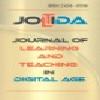The Effects of STEM and Other Innovative Interdisciplinary Practices on Academic Success, Attitude, Career Awareness: A Meta-Synthesis Study
The Effects of STEM and Other Innovative Interdisciplinary Practices on Academic Success, Attitude, Career Awareness: A Meta-Synthesis Study
STEM, STEAM, interdisciplinary approach meta synthesis, innovative applications,
___
- Achilleos, A. P., Mettouris, C., Yeratziotis, A., Papadopoulos, G. A., Pllana, S., Huber, F., &Dinnyes, A. (2018). SciChallenge: a social media aware platform for contest-based STEM education and motivation of young students. IEEE Transactions on Learning Technologies, 12(1), 98-111.
- Affleck, F. (2018). Enabling Innovation throughMindset: Private Schools in Dubai, United Arab Emirates.
- Armknecht, M. P. (2015). Case study on the efficacy of an elementary STEAM laboratory school (Doctoral dissertation, Lindenwood University).
- Blotnicky, K. A., Franz-Odendaal, T., French, F., & Joy, P. (2018). A study of the correlation between STEM career knowledge, mathematics self-efficacy, career interests, and career activities on the likelihood of pursuing a STEM career among middle school students. International journal of STEM education, 5(1), 22.
- Büyüköztürk, Ş., Çakmak, E. K., Akgün, Ö. E., Karadeniz, Ş., &Demirel, F. (2017). Bilimsel araştırma yöntemleri [Scientific Research Methods in Education]. Pegem Atıf İndeksi, 1-360.
- Chonkaew, P., Sukhummek, B., & Faikhamta, C. (2016).Development of analytical thinking ability and attitudes towards science learning of grade-11 students through science technology engineering and mathematics (STEM education) in the study of stoichiometry. Chemistry Education Research and Practice, 17(4), 842-861.
- Cohen, J. D., Renken, M., & Calandra, B. (2017). Urban Middle School Students, Twenty-First Century Skills, and STEM-ICT Careers: Selected Findings from a Front-End Analysis. TechTrends, 61(4), 380-385.
- Cole, P. (2016). Measuring the Effectiveness of Software-Based Training to Improve the Spatial Visualization Skills of Students in STEM Disciplines in Higher Education Institutions.
- Demirel, T. (2010). Bloglarin Öğretim Amaçli Kullanimi Üzerine Öğretmen Adaylarinin Görüşleri [Teachers' Opinions on the Use of Blogs for Teaching Purposes]. Unpublished master’s thesis, Atatürk Üniversitesi, Erzurum, Turkey.
- Egli, S. (2012).Using STEM education to promote 21st century math skills. Unpublished master dissertation, Minot State University, North Dakota.
- Ejiwale, J. A. (2013). Barriers to successful implementation of STEM education. Journal of Education and Learning, 7(2), 63-74.
- Sayary, E., & Adel, A. M. (2014). The Effectiveness of Problem-Based Learning Strategy in STEM Education for Enhancing Students’ 21st Century-Skills (Doctoral dissertation, The British University in Dubai (BUiD)).
- El-Deghaidy, H., & Mansour, N. (2015). Science teachers’ perceptions of STEM education: Possibilities and challenges. International Journal of Learning and Teaching, 1(1), 51-54.
- Flick, A. (2019). The Effects of Flipped Learning in the Sixth-grade Mathematics Classroom (Doctoral dissertation, Missouri Baptist University).
- Gibson, J. J. (2017). An Assessment of Factors Relating to High School Students' Science Self-Efficacy (Doctoral dissertation, Pepperdine University).
- Gumaelius, L., & Nymark, T. (2017). The Technology-Eight Competition: An analysis of Year 8 Students’ Quiz Results. NorDiNa: Nordic Studies in Science Education.
- Heck, C. (2017). Integração de tecnologia no ensino de físicanaeducaçãobásica: um estudo de casoutilizando a experimentaçãoremotamóvel (Doctoral dissertation, Universidade Federal de Santa Catarina).
- Hsu, Y. S., Lin, Y. H., & Yang, B. (2017). Impact of augmented reality lessons on students’ STEM interest. Research and Practice in Technology Enhanced Learning, 12(1), 1-14.
- Hunter, J. E., & Schmidt, F. L. (2004). Methods of meta-analysis: Correcting error and bias in research findings. Sage.
- Jones, C. A. (2018). Perceptions of Students on the Impact of Science, Technology, Engineering, and Mathematics Integration on High School Career Choices (Doctoral dissertation, Tennessee State University).
- Jeong, S., & Kim, H. (2015).The Effect of a Climate Change Monitoring Program on Students' Knowledge and Perceptions of STEAM Education in Korea. EURASIA Journal of Mathematics, Science & Technology Education, 11(6), 1321-1338.
- Kang, H., Calabrese Barton, A., Tan, E., D Simpkins, S., Rhee, H. Y., & Turner, C. (2018). How do middle school girls of color develop STEM identities? Middle school girls’ participation in science activities and identification with STEM careers. Science Education, 103(2), 418-439.
- Kim, M. K., & Cho, M. K. (2015). Design and implementation of integrated instruction of mathematics and science in Korea. EURASIA Journal of Mathematics, Science and Technology Education, 11(1), 3-15.
- King, D., & English, L. D. (2016). Engineering design in the primary school: Applying STEM concepts to build an optical instrument. International Journal of Science Education, 38(18), 2762-2794.
- Knezek, G., Christensen, R., Tyler-Wood, T., &Periathiruvadi, S. (2013).Impact of Environmental Power Monitoring Activities on Middle School Student Perceptions of STEM. Science Education International, 24(1), 98-123.
- Kong, Y. T., &Huo, S. C. (2014). An effect of STEAM activity programs on science learning interest. Advanced Science and Technology Letters, 59, 41-45.
- Koul, R., Fraser, B., & Nastiti, H. (2018). Transdisciplinary instruction: Implementing and evaluating a primary-school STEM teaching model. International Journal of Innovation in Science and Mathematics Education (formerly CAL-laborate International), 26(8). 17-29.
- Yayın Aralığı: 2
- Başlangıç: 2016
- Yayıncı: Mehmet Akif Ocak
Design Considerations for 3-D Exergames
Bahattin Selim PAMUKCU, Hasan ÇAKIR
Adapted text benefits for teachers and students: A retroactive case study
The Perceived Benefit of a 3D Anatomy Application (App) in Anatomy Occupational Therapy Courses
Integrating Engineering, Science, Reading, and Robotics across Grades 3-8 in a STEM Education Era
Hasan DENİZ, Erdogan KAYA, Ezgi YESİLYURT, Anne NEWLEY, Emily LİN
Evrim ÜSTÜNLÜOĞLU, Robert DAHLGREN
Esra Çoban BUDAK, Aynur Kolburan GEÇER, Arzu Deveci TOPAL
Agâh Tuğrul KORUCU, Kadir KABAK
Data Science and Human Behaviour Interpretation and Transformation
